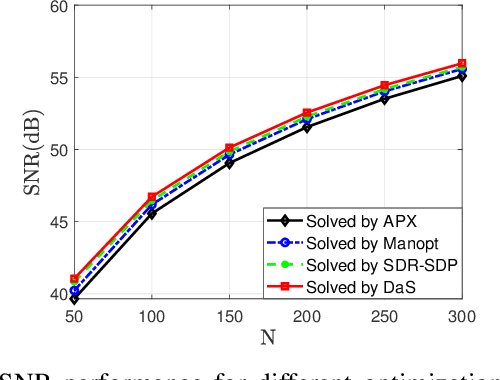Xuehui Dong
Group Sparsity Methods for Compressive Space-Frequency Channel Estimation and Spatial Equalization in Fluid Antenna System
Mar 03, 2025Abstract:Fluid Antenna System (FAS) unlocks unprecedented flexibility in wireless channel optimization through spatial reconfigurability. However, its practical deployment is hindered by the coupled challenges posed by high-dimensional channel estimation and real-time position optimization. This paper bridges wireless propagation physics with compressed sensing theory to address these challenges through three aspects. First, we establish a group-sparse recovery framework for space-frequency characteristics (SFC) in FAS, formally characterizing leakage-induced sparsity degradation from limited aperture and bandwidth as a structured group-sparsity problem. By deriving dictionary-adapted group restricted isometry property (D-GRIP), we prove tight recovery bounds for a convex $\ell_1/\ell_2$-mixed norm optimization formulation that preserves leakage-aware sparsity patterns. Second, we develop a Descending Correlation Group Orthogonal Matching Pursuit (DC-GOMP) algorithm that systematically relaxes leakage constraints to reduce subcoherence. This approach enables robust FSC recovery with accelerated convergence and superior performance compared to conventional compressive sensing methods like OMP or GOMP. Third, we formulate spatial equalization (SE) as a mixed-integer linear programming (MILP) problem, ensuring optimality through the branch-and-bound method. To achieve real-time implementability while maintaining near-optimal performance, we complement this with a greedy algorithm. Simulation results demonstrate the proposed channel estimation algorithm effectively resolves energy misallocation and enables recovery of weak details, achieving superior recovery accuracy and convergence rate. The SE framework suppresses deep fading phenomena and reduces hardware deployment overhead while maintaining equivalent link reliability.
Wireless Communications in Cavity: A Reconfigurable Boundary Modulation based Approach
Nov 15, 2023



Abstract:This paper explores the potential wireless communication applications of Reconfigurable Intelligent Surfaces (RIS) in reverberant wave propagation environments. Unlike in free space, we utilize the sensitivity to boundaries of the enclosed electromagnetic (EM) field and the equivalent perturbation of RISs. For the first time, we introduce the framework of reconfigurable boundary modulation in the cavities . We have proposed a robust boundary modulation scheme that exploits the continuity of object motion and the mutation of the codebook switch, which achieves pulse position modulation (PPM) by RIS-generated equivalent pulses for wireless communication in cavities. This approach achieves around 2 Mbps bit rate in the prototype and demonstrates strong resistance to channel's frequency selectivity resulting in an extremely low bit error rate (BER).
Transforming RIS-Assisted Passive Beamforming from Tedious to Simple: A Relaxation Algorithm for Rician Channel
Nov 22, 2022Abstract:This paper investigates the problem of maximizing the signal-to-noise ratio (SNR) in reconfigurable intelligent surface (RIS)-assisted MISO communication systems. The problem will be reformulated as a complex quadratic form problem with unit circle constraints. We proved that the SNR maximizing problem has a closed-form global optimal solution when it is a rank-one problem, whereas the former researchers regarded it as an optimization problem. Moreover, We propose a relaxation algorithm (RA) that relaxes the constraints to that of Rayleigh's quotient problem and then projects the solution back, where the SNR obtained by RA achieves much the same SNR as the upper bound but with significantly low time consumption. Then we asymptotically analyze its performance when the transmitter antennas n_t and the number of units of RIS N grow large together, with N/n_t -> c. Finally, our numerical simulations show that RA achieves over 98% of the performance of the upper bound and takes below 1% time consumption of manifold optimization (MO) and 0.1% of semidefinite relaxation (SDR).
Optimal Discrete Beamforming of Reconfigurable Intelligent Surface
Nov 09, 2022Abstract:Utilizing reconfigurable intelligent surface (RIS) for communication service usually leads to non-convex optimization problems. Existing methods either suffer from significant scalability issues or lead to local optima. This paper focuses on optimal beamforming in RIS-aided single input single output (SISO) communications. We formulate the discrete beamforming into a discrete product maximization problem, a fundamental yet unexplored problem. A highly efficient divide-and-sort (DaS) search framework is developed. The proposed approach is guaranteed to find global optima with linear search complexity, both in the number of discrete levels and the length of vectors. This approach is seen as particularly effective for large scale problems. Numerical studies about the effectiveness and speed of DaS are also presented. Extensive trails show that, for moderate resolution quantization, e.g., 4-bits and above, there seems to be no noticeable difference between continuous and discrete phase configuration.
RIS-aided Wireless Communication with $1$-bit Discrete Optimization for Signal Enhancement
Sep 12, 2022



Abstract:In recent years, a brand-new technology, reconfigurable intelligent surface (RIS) has been widely studied for reconfiguring the wireless propagation environment. RIS is an artificial surface of electromagnetic material that is capable of customizing the propagation of the wave impinging upon it. Utilizing RIS for communication service like signal enhancement usually lead to non-convex optimization problems. Existing optimization methods either suffers from scalability issues for $N$ number of RIS elements large, or may lead to suboptimal solutions in some scenario. In this paper, we propose a divide-and-sort (DaS) discrete optimization approach, that is guaranteed to find the global optimal phase shifts for $1$-bit RIS, and has time complexity $\mathcal{O}(N \log(N))$. Numerical experiments show that the proposed approach achieves a better ``performance--complexity tradeoff'' over other methods for $1$-bit RIS.
 Add to Chrome
Add to Chrome Add to Firefox
Add to Firefox Add to Edge
Add to Edge